Editorial
Downunder, it's autumn at last—and why am I wishing my life away? Answer: because summer is hot, Hot, HOT! Meanwhile, our Federal Government, who have been managing the economy quite well, have been doing their level best to tear themselves apart. Her Majesty's Loyal Opposition has been remarkably quiet during all these ructions. Just perhaps their leader has been reminded of a maxim attributed to Napoleon Bonaparte which goes something like: ..never interrupt your enemy while they are busy making a mistake... 'Nuf said.
As we get closer to the ten year anniversary of the current MEN format, I find myself remembering old Editorials where I had fun ranting and wailing about span email. Today it's no longer a problem to me, thanks mostly to Google. I have several active mail accounts which I've arranged for a single Google account to harvest, passing them through their spam filters before reaching my in boxes. This works so well that I almost never see any spam. It's there though. My spam folder, which purges mail more than 30 days old, currently contains 879 entries. That's about 30 spams per day.
Our public radio has a weekly feature called "Future Tense" (good pun). Recently, they devoted an episode to Spam, estimating that it accounts for 80% of all email traffic (you can listen to it as a podcast if you are quick). If you google for confirmation of this estimation, you'll find figures between 73 and 90%, so we can agree it's a big number. And where does it come from? The answer is tens of thousands of home computers, all running Microsoft Windows, which have been quietly taken over without their owners noticing. These "Spambots" and are controlled remotely to distribute spam emails. The radio program reported that last year, a server farm which was known to be a control point for farms of spambots was shut down by legal action. The amount of spam on the Internet immediately dropped by a gigantic figure, gradually increasing as the spammers rebuilt their network. This is simplified for them by the weakness of Windows security.
As the program pointed out, most spammers are not that tech savvy. They rely on hacking "toolboxes" built by a small number of quite smart sociopaths. If everyone switched to Linux, or bought an Apple (which runs BSD Unix under the hood), life would be a lot harder for spammers, and the toolkit authors. Yes, I know, not going to happen, but I can dream.
Somewhat to my surprise, MEN Central has slowly been transiting to an Apple shop. I have a giant iMac used for development, an iPad, and Ruthie and I use iPhones. My main work box is still Linux, and I keep an XP box for CAD work, but I'm finding I can get far better home automation thanks to Apple's little gizmos. For instance, we can sit by the pool, listening to our record collection, streamed from the iMac to a portable B&O boombox over WiFi, all controlled by our iPhones. The setup was very simple. Maybe it could be done under Windows, but I would not like to try to configure nor administer the thing.
Ok, enough of my anti-microsoft ranting. We have a good issue for you this month, including a new free plan (Members Only), some new stuff, and some updated stuff. Hope some part of it interests you.
DNS Woes

DNS is a TLA (three letter abbreviation) for Directory Name Service. This is the piece of software which translates human readable domain names into the numbers that are used to actually contact web and email servers. There are thousands of these, but only one will be "authoritative" for an individual domain name—the rest just cache the data to speed up name translation. As a mistake in the data table which underlies each DNS could have ugly ramifications for the Internet, other DNS check lower level DNS and effectively cut them out if there is an error. This means that all the domains defined by the offending DNS disappear (after a TTL (Time To Live) interval).
This has happened on the Model Engine News DNS three times so far this year. I've made my displeasure known to my ISP who, in turn, has had words with the sysadmins for the server which hosts this site. Everybody's very sorry, including me, but there's not a lot I can do except monitor the situation. Emailing me should this happen is not going to work either as when the MEN web site disappears, so does my email address. Mail's "store and forward" means I should eventually get the mail, but by that time, MEN will be back on line. Let's just happen it does not happen again, soon.
Wanted: Miss E.D. 2
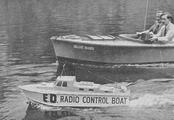
Sixty years ago last September, a six foot radio controlled motor launch made the crossing from the Port of Dover, England, to Calais, France, taking approximately ten hours for the trip. The model was named Miss EeDee. She was propelled by a prototype ED Mk V 4.5cc diesel designed by Basil Miles, Engineering Director of Electronic Developments Ltd (ED), using ED's new Mk VI radio control gear designed by George Honest-Radclich, launch "pilot", and designer of ED's radio control equipment range. In 1952, ED marketed a half-scale model of the channel-crossing launch, named Miss E.D. 2.
In 1957, a similar crossing was made from Helsinbourg (Sweden) to Helsingör (Denmark), again using ED radio equipment. During the past month, we received an email from Mr Tomas Leijon who plans to make a longer crossing, over the Baltic sea from Sweden to Finland, to raise money for the Medecins sans Frontieres (Doctors without Borders) fund. Tomas will build the boat and would like to model it on the original Miss EeDee, but all he has is some photos and very basic dimensions which we were able to supply from an old issue of Model Maker. If any reader is able to help with drawings of Miss EeDee, or the half-scale Miss E.D. 2, please contact us through the email address at the foot of this page. We think it's a worthy project, for an equally worthy cause.
Mini Sparking Plugs
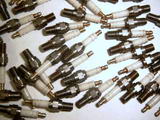
Ok, I know we call them "spark plugs" today, but the old English term, "sparking plugs", has always felt somehow more powerful to me. What we see here are the new miniature plugs made and sold by Dale Dietrich. How mini? The thread is 8-40 (major diameter 0.164", or 4.17mm). The cost is US$16.00 for quantity 1 - 8, or $15 for 9+. Not really expensive after you consider that the closest equivalent is the Rimfire 10-40 (0.190", 4.83mm) which cost US$22 each. Regarding quality, Dale says "I put each plug on a high frequency ac generator and run the plugs to burn a good spot for the ground end of the arc... Plus it is a higher power and I can heat the plug up by running it for a short time. Then I fire the plugs on a points/coil system and set the center electrode for a "nice" fat arc". Each plug comes with a copper gasket and I'm unsure whether Dale can also supply the 8-40 tap as this is neither UNC, nor UNF according to my thread book, but then neither is 10-40! Contact Dale for more details, and thanks go to Steve, Little Demon V8, Huck for this news item.
Wall and Coles and Oops
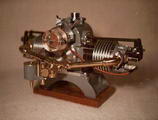
See what happens when you rely on "memory" and don't check your facts? I'm pleased and embarassed to say that contrary to last month's comment on the current unavailability of castings for Elmer Wall's engine designs, a number are still available through Coles' Power Models of Texas. I had problems getting their web site to display descriptions against the illustrations, so I'm guessing here that there may be as many as six Wall kits available. Sorry 'bout that, Chief. The Elmer Wall Tribute page has been updated accordingly.
Here Come The Vipers
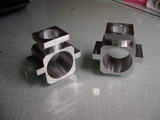
Since release of the Nalon Viper page, we've dispatched a good half-dozen plan sets to potential Viper builders. Here's progress do date by Charlie Stone (Australia) who is sensibly building two at once. I've proven more than once that you can build two at once in not much more time than it takes to build one. This is partly due to the time it takes for setups; machining the part is small in comparison, so if you can reuse a setup, you get two parts in almost the time it takes to do one. The second advantage is psychological—for me, at least. I know when I should spend time to make a jig, or fixture to hold a part for machining. If I'm doing just one, I tend to end up thinking it's not worth the effort and end up taking longer and getting an inferior job. When faced with making two of something, I'm more likely to say ok to making a special jig. It may be different for you—as I said, it's a personal hang-up for me.
Rossi .15 Mk I
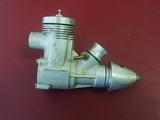
This is actually another round in the Schnuerle Wars, but I thought I'd hide the topic under an innocuous heading in case you are getting a bit sick of it. An email from Jon Fletcher suggested that perhaps the "first commercial Schnuerle" prize should go to Rossi for their 1967 Mk I .15 FRV, TBR. Certainly from external appearance, we can see the signature features of "raked back" main transfer passages and a boost port transfer bulge opposite the rear-facing exhaust.
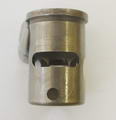
The real story however is in the liner. This shot, taken from the exhaust side, clearly shows the two side transfer ports are angled to direct the flow to the cylinder side opposite to the exhaust. Also clearly visible is the boost port, timed to open after the main transfers and direct the flow upwards. Sure quacks like a Schnuerle, doesn't it? The liner has been modified slightly by a previous owner for use in the 1967 F1C World Championships, but the mods are to smooth the external port entries, not their actual shape.

So do we have to re-award The Crown? No reviews of the engine appear until February, 1973 when Peter Chinn reviewed the Rossi R-15 "Normale" (non-pipe) engine for Aeromodeller. In his review, Chinn describes the engine as "...twin ball-bearing shaft-valve racing type motor having the now familiar features of Schneurle loop scavenging and rear exhaust." (p88). He also notes that the Rossi brothers spent more than five years developing the engine before production models were released, and that supply is well below demand. From this it might be argued that Jon's 1967 engine was a pre-production engine made available to a world-class competitor for field evaluation. I'm going to hold off on revising the first commercial Schnuerle award as we know that the Paul Bugl designed HP .15 was available, commercially, in small numbers in 1967 (Gordon Burford obtained one in 1968 for study). So far, I've no data on how many Mk I Rossi .15's were produced in 1967, but I find it noteworthy that by 1973, Chinn is effectively saying that Schnuerle loop scavenging is old-hat.
Hippo Birdy 2 Me

It being March, we celebrate my birthday with a new Free Plan for MEN Members. This time, it's the rather nice little EmBee 75, a bar-stock diesel from the UK, circa 1968-70. It is effectively a beam mount stable-mate for the PMC Imp. Both make very nice engines for home construction, well able to power a small free-flight, or R/C model. In real life, the EmBee was very nicely made in comparison the later (1980) Imp, but Members have had great success with the Imp simply by applying the care and attention to fits that was somewhat lacking in the original. The EmBee is more work and requires milling (or a lot of sawing and filing), but it too will make a fine running engine which is perhaps easier to mount in an airframe. Members click on the thumb-nail to log-in and download your Free Plan. Non-members, Join! As well as your copy of the EmBee, you get access to another twenty-nine CAD model engine plan sets.
New Carlsbad Museum Video

And if you are wondering what the devil a promo for a video of some underground caverns—regardless of how spectacular they might be—is doing here in Model Engine News, then you, like me, need to adjust your association with the location, "Carlsbad", as that is the home of The Joe Martin Foundation Craftsmanship Museum. An email this past month pointed me to a new video walk-thru of the museum recently posted on UTube (click the thumbnail, or go to http://youtu.be/BbbjGg5_dIk). The displays and the presentation are a credit to Joe, his staff, and the remarkable skill of all the craftsmen whose work is on display. I even noticed a photo of yours truly on the wall which, naturally, has nothing to do with why I'm plugging the video  . The Museum should be a first-stop if you are visiting the San Diego area (you can go to the Aerospace Museum afterwards, if you have time...)
. The Museum should be a first-stop if you are visiting the San Diego area (you can go to the Aerospace Museum afterwards, if you have time...)
New Books and Magazines This Month
This month we have a small treatise I obtained a couple of years back and have been trying ever since the decide whether or not to inflict it upon you. Seeing as the book reviews for the past two months have been about two-stroke engines, first with Oxley's Stealing Speed, then with Irvine's Two Stroke Power Units, I think it is appropriate to look at a biography of the man/men credited with inventing the piston ported engine—what we'd call a "side-port" in model engine country.
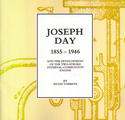
The booklet is titled, Joseph Day 1855—1946 And The Development Of The Two-Stroke Internal-Combustion Engine, by Hugh Torrens, Bath Industrial Trust Ltd, Bath UK, 1991, ISBN 0951860208. The booklet is soft covered, roughly 10" x 10", with twenty-four pages, alternating images and text (with lots of white space), except for the center pages which both are text. It describes what little is known today about Mr Day and his development of the simplest form of internal combustion engine—just three moving parts. Although it was initially ignored, especially in Day's home country, the engine now forms the basis of an almost infinite garden of power units, big and small. Any way you look at it, this was one very important invention!
With only thirteen pages of words, a decent precis will just about regurgitate the entire text, but as the booklet is not that easy to locate, this may be no bad thing. In 1952, the keeper at the London Science Museum appealed for any biographical data about Joseph Day, whom he termed, [the] supposed "inventor of the crankcase-compression engine". His appeal drew absolutely zero response. The author states his book is an attempt to consolidate what little is known, and to analyze why Day has slipped through the net of history (unquote).
Simply put, Joseph Day was a Crystal Palace trained engineer in the times of Victorian England. Following formal study, an apprenticeship and "pupilage" in Somerset between 1874 and 1877, he formed his own company in 1878 and achieved some early success in diverse areas such as mobile hand-cranes, high-level waterworks (for the City of Bath, where his engineering company was located), and mechanized bread making.
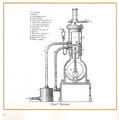
Apparently possessing an enquiring mind, Day set about development of an internal combustion engine which would not conflict with the ever-constant litigation in England over the Otto (four-cycle) patent. In 1891, he applied for a patent on the Day two-port two-stroke engine. The patent, #6,410, was granted in June 1892. In the same year, Frederic William Caswell Cock applied to patent an improvement on Day's two-port invention, replacing the the flap-valve used for induction with a piston controlled inlet port. The result was the simple three-port two-stroke we know today. Cock was a workman at Day's Bath engineering works, so the patent was assigned to Day, who probably paid for it to be taken out.
Day saw the engine as a portable electric generator, but interest in Great Britain was low, so Day traveled to the United States to try to sell his American two-stroke engine patents. But back at home, his involvement with the mechanized bread maker brought him under scrutiny, resulting in a 1894 summons to prosecute Day and another company official with fraud and other charges. The Judge eventually found Day had no case to answer, but the damage was done and Day was forced into bankruptcy. Torrens says this occurred in September, 1893, and that the case came to court in June 1894, following the summons of February, that year. Seems like cart before the horse, but perhaps not impossible.
It seems however that Day had some success in the US with his patent and by 1906, at least twelve US companies had taken out licenses on the Day-Cock engine, principally for use as motor-boat engines. Of these it is estimated that Palmers Bros of Cos Cob, Connecticut built and sold over 60,000 engine prior to 1912. As a result, Day was able to discharge his bankruptcy in April, 1906, paying 3-15/16 pence in the pound (one pound was worth two hundred and forty pence). Following World War I, convinced that petrol was the power source of the future, Day invested in a venture to extract oil from Jurassic oil-shale in Norfolk, in the east of England. This was a second financial disaster for Day, who sank into obscurity until 1952 when the Science Museum appealed for information about him—just five years after his death at the age of 91 in 1946.
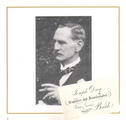
The book contains this photo of Joseph Day, taken in 1920, plus other reproductions of diagrams and photos showing some of his early portable hand-cranes, and an example of the Day-Cock engine (sectioned), from the Daimler-Benz collection, currently residing in the Deutsches Museum, Munich. It is numbered 165 of 1892 and has a bore of 82mm and stroke of 133mm for a displacement of 0.86 litre (860cc), and was able to attain 900 rpm. The booklet Introduction is provided by Lyle Cummins, author of Internal Fire, a book I consider the last word on the history of the development of internal combustion engines. On checking what Cummins has to say about Day, we find less than half a page (p218). It mentions the three-port patent, but not Fredrick Cock, who to my mind is about as significant in his contribution as was Day. This underscores just how little Day and Cock are recognized in comparison with other two-stroke pioneers such as Dugald Clerk, and Karl Benz.
The booklet, which we probably should call a treatise, or even an essay, is well researched and extensively footnoted. Just the thing for scolarly research, but of little use to someone who wants the gritty details of Day's engines. Nevertheless, I'm glad I've read it and now know who we can thank for the basis of all model engines. That said, I can't really award it more than three stars  . You may be able to find a copy through ABE Books, or perhaps the Bath Industrial Heritage Centre itself.
. You may be able to find a copy through ABE Books, or perhaps the Bath Industrial Heritage Centre itself.
Engine Of The Month: Hornet
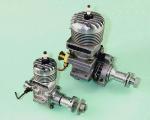
One thing I try to remain mindful of is the global nature of Model Engine News's readership. Monthly web server stats tell precisely how many hits we get, and where they come from. It should be no surprise that the majority of our readers are US based. In January 1012, the top five were, in decreasing order of volume, the United States, Great Britain, Australia, Canada, and Germany. All readers like our technical articles, the Gallery, and Watzits. When it comes to engines, I know many readers like reading about the ones they don't know about, but the numbers suggest a bias to engines from a reader's country of origin, so if we are being "fair" we should make sure that we balance our engine reviews across the international readership numbers. All this is a lead-in and apology of sorts to say that this month, it's time we paid more attention to our friends in the United States with an in-depth look at a racing .60 which has effectively persisted from the 1930's right through to today, to wit, the Hornet. As usual, Adrian has done his best to delve into the engine's background and uncover some facts which we believe have never been published anywhere before now. We sure hope that everybody, everywhere enjoys it.
Tech Tip of the Month

Back when I was a kid, all my model flying friends knew exactly how and why a glow plug worked. In fact, demonstrating superior knowledge of how something worked was a measure of your "street creds", to use a modern term, so we voraciously consumed articles from Aeromodeller, Model Airplane News, and all the rest in the hopes of besting our friends in the knowledge stakes. This depth of understanding seems to be yet another thing of the past. Recently, a series ran in the Model Engineer on building a scaled-up Whittle V8 aero engine. In the last part, the author confessed that he know very little about glow plugs and was grateful to the people at his local model shop for setting him straight. I've no issue with our author for that; asking questions is one way of gaining understanding. Sadly, it seems that his source was a dollar short in his understanding, so our unknowing author ended up passing on less than accurate information in his article.
As I said, not really his fault. But when I read it, I was moved sufficiently to write to the editor, providing what I believe are the missing aspects to the story on why a glow plug works, feeling that the readership had been very poorly served with incomplete information. I did my best to compose the information concisely in the hopes that it would be published. I also groveled a bit to increase the chance of publication. Maybe I should have been more controversial, as the ME readership remains misinformed on why and how a glow plug works. On the theory that perhaps some younger MEN readers are not fully aware of the ins and outs of glow plug theory, here's my letter the Editor, reformatted:
What to do when you spot a small mistake, or over-simplification in print? Mostly I take the lazy way out and ignore it under the assumption that I'm over pedantic and if it is annoying enough to the readership, someone else will correct it. For once I'll be more proactive as I can't help noticing (and applauding) the increased coverage and interest in Internal Combustion engines in the ME over the past year or so. This being so, readers new to the subject should receive the whole truth, not a distorted part of it.
On page 738 of Issue 4418 in Mick Knights' series on building his enlarged Whittle Aero V8, he admits to scant knowledge of glow plugs, relying on advice from a model shop who had "hopefully" put him on the right track saying that "...the only current required is the initial burst that ignites the fuel on the first compression cycle, after which the current is switched off and the heat from combustion keeps the plugs working". Partially true, but close enough should never be good enough for the well informed Model Engineer.
I'll keep this brief and skip some edge considerations, but basically, once the engine is operating smoothly, continued heating is provided by three actions:
- Heat carried over in the element from the previous combustion cycle,
- Heat created by rise in temperature of air in the cylinder due to compression (the glow engine has been called the "semi-diesel", but that is misleading too as what, in the model engine fraternity, we referred to as a "diesel", is actually a "compression ignition" engine),
- Heat added by the exothermic (heat releasing) catalytic action between the platinum alloy of the plug coil and the methyl alcohol in the fuel.
The order of significance is generally 3, 2, 1. Stories of glow engines starting without batteries are not apocryphal. I've actually been holding a model with a glow engine when it started in response to a casual flip of the prop without the battery even being attached to the engine, which was completely cold at the time. The start was totally due to actions 2 and 3 listed above. A user who thinks the glow plug works simply by the incandescent heating effect could be in for a surprise. Extremely uncommon, I'll admit, but you won't know it can happen if you don't know how the glow plug really works.
I recommend Dave Gierke's book, "2-stroke Glow Engines" (ISBN 0911295305) as the best available on the theory of glow plug engines, their development history, operation, and maintenance.
Best regards...
Interestingly, Ray Arden's patent #2,482,831 does not mention the catalytic action between platinum and alcohol vapor. Perhaps he was trying to maintain a commercial edge by keeping the element alloy secret. Who remembers the "magic" gas lighter? A wand with a platinum coil on the end, totally un-powered, which would glow red hot when placed in the stream of gas from a hob on a gas cook top? It these days of self-igniting gas ranges, there is no need for such things, so I'm not that surprised that younger folk have never seen catalytic action of this type. For those interested, pdf's of the various patents granted to glow plug inventors are available through Free Patents Online. Convenient links to most of them were collected on this RC Universe thread.
YA IMP

In the book publishing business, "YA" is short for "Young Adult". In the computer world, it means "Yet Another". Despite appearances, the engine you are looking at here is not a dieselized K&B Infant, it's yet another Imp (I've lost count of the number of times that name has been used for a model engine). The design began as a fun project in the US. After some serious development work, the results were so good that quantity production of the little 0.020 cuin (0.33cc) engine is being arranged with the company who makes the remarkable Cyclon F1J engines. If all goes to plan, we'll let you know more about it next month. Thanks to David Owen of Owen Engines Australia for this piece of news. If the engine is all that is claimed, David will be adding it to his price list.
Briefly Noted
This section is intended to alert you to little things that are hard to expand to a full news item, or cunningly wind into the Editorial, but are worthy of note never the less.
- We've updated/corrected the physical address for Polly Engineering Ltd (UK) after a very nice email exchange with Polly's owner and fellow ex-academic, Pete Thomas. Polly supply the kit for the nice little external hone which I find totally indispensable for crankshafts and piston finishing. They supply lots of other kits and goodies too—well worth a visit.
- Model Engine Builder is having a sale on back issues. Numbers 1, 2, 5, 6, 7, 9, 11-20 and 22-26 are available for $2.00 off the cover price (plus postage). Numbers 3, 4, 8, 10 and 21 are currently out of stock but you can place back orders for these at the same special price. Contact the Publisher, or phone them during California weekday business hours, 9 AM to 5 PM Pacific Time, at 1.866.996.8999 in the U.S. or Canada (toll-free), 0.01.707.643.1970 elsewhere, or fax to 0.01.707.557.6652.
- We have a new Watzit that we suspect we'll never know more about, but it's fun to look at the pictures and guess what the designer might have had in mind in relation to the engine's unconventional features. Check out the Gatehouse of Fleet (and yes, all will be explained...)
- David Owen spotted a glaring error in the sample page posted last month with the review of Irvine's Two Stroke Power Units. He also noted that one of the engines in the timing chart was made by Victa, the pioneering Australian rotary motor mower company. Finding the error is left as an exercise for the reader...

 DNS Woes
DNS Woes
 Wanted: Miss E.D. 2
Wanted: Miss E.D. 2
 Mini Sparking Plugs
Mini Sparking Plugs
 Wall and Coles and Oops
Wall and Coles and Oops
 Here Come The Vipers
Here Come The Vipers
 Rossi .15 Mk I
Rossi .15 Mk I
 Hippo Birdy 2 Me
Hippo Birdy 2 Me
 New Carlsbad Museum Video
New Carlsbad Museum Video
 YA IMP
YA IMP
 Editorial
Editorial
 New Books and Magazines This Month
New Books and Magazines This Month
 Engine Of The Month: Hornet
Engine Of The Month: Hornet
 Tech Tip of the Month
Tech Tip of the Month
 Briefly Noted
Briefly Noted
 Standard Stuff
Standard Stuff











 . The Museum should be a first-stop if you are visiting the San Diego area (you can go to the
. The Museum should be a first-stop if you are visiting the San Diego area (you can go to the 


 . You may be able to find a copy through
. You may be able to find a copy through 

